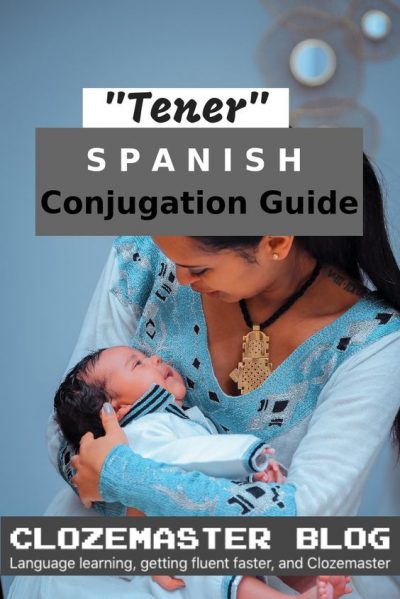
In this lesson, you will learn all there is to know about conjugating tener. You’ll also learn how to use the verb phrase tener que in Spanish and will discover the different meanings of this Spanish verb. Ready? Let’s dive into it!
Tener in Spanish
Tener in English is either to have or to be. It is translated as to have when it means “to possess” in Spanish. For example, “Yo tengo una casa” is “I have a house” in English.
In the following expressions, tener means to be:
| tener calor | to be hot |
| tener celos | to be jealous |
| tener cuidado | to be careful |
| tener frío | to be cold |
| tener razón | to be right |
| tener sed | to be thirsty |
| tener hambre | to be hungry |
| tener verguenza | to be ashamed |
How to Conjugate Tener in Spanish
Below you’ll find the proper conjugation of tener. We used the current verb conjugation reference of tener provided by the Royal Spanish Academy (RAE). Since they only include simple Spanish tenses in their reference because of space limitations, we have added the conjugations of both simple and compound Spanish tenses in this guide.
Spanish Verbals of Tener
| Infinitive | tener |
| Gerund | teniendo |
| Participle | tenido |
Indicative Mood
I’ll give you a tip to help you always conjugate the tener preterite right! Do you already know the preterite of estar? Then, just eliminate the first two letters (es) from all the forms of the estar preterite. For example, “yo estuve” becomes “yo tuve”. That’s it! Now you have the correctly conjugated preterite of tener.
Tiempos Simples – Simple Tenses
Presente – Present Tense Conjugation
| yo tengo | I have |
| tú tienes vos tenés (South American) |
you have |
| él/ella/usted tiene | he/she has you (formal) have |
| nosotros/nosotras tenemos | we have |
| vosotros/vosotras tenéis ustedes tienen |
you (plural) have |
| ellos/ellas tienen | they have |
Pretérito Imperfecto – Imperfect Tense Conjugation
| yo tenía | I had |
| tú tenías vos tenías (South American) |
you had |
| él/ella/usted tenía | he/she/you (formal) had |
| nosotros/nosotras teníamos | we had |
| vosotros/vosotras teníais ustedes tenían |
you (plural) had |
| ellos/ellas tenían | they had |
Pretérito Perfecto – Preterite Tense Conjugation
| yo tuve | I had |
| tú tuviste vos tuviste (South American) |
you had |
| él/ella/usted tuvo | he/she/you (formal) had |
| nosotros/nosotras tuvimos | we had |
| vosotros/vosotras tuvisteis ustedes tuvieron |
you (plural) had |
| ellos/ellas tuvieron | they had |
Futuro – Future Tense Conjugation
| yo tendré | I will have |
| tú tendrás vos tendrás (South American) |
you will have |
| él/ella/usted tendrá | he/she/you (formal) will have |
| nosotros/nosotras tendremos | we will have |
| vosotros/vosotras tendréis ustedes tendrán |
you (plural) will have |
| ellos/ellas tendrán | they will have |
Condicional – Conditional Tense Conjugation
| yo tendría | I would have |
| tú tendrías vos tendrías (South American) |
you would have |
| él/ella/usted tendría | he/she/you (formal) would have |
| nosotros/nosotras tendríamos | we would have |
| vosotros/vosotras tendríais ustedes tendrían |
you (plural) would have |
| ellos/ellas tendrán | they would have |
Tiempos Compuestos – Compound Tenses
Pretérito Perfecto Compuesto – Preterite (Present) Perfect Tense Conjugation
| yo he tenido | I have had |
| tú has tenido vos has tenido (South American) |
you have had |
| él/ella/usted ha tenido | he/she has had you (formal) have had |
| nosotros/nosotras hemos tenido | we have had |
| vosotros/vosotras habéis tenido ustedes han tenido |
you (plural) have had |
| ellos/ellas han tenido | they have had |
Pretérito Pluscuamperfecto – Pluperfect Tense Conjugation
| yo había tenido | I had had |
| tú habías tenido vos habías tenido (South American) |
you had had |
| él/ella/usted había tenido | he/she/you (formal) had had |
| nosotros/nosotras habíamos tenido | we had had |
| vosotros/vosotras habíais tenido ustedes habían tenido |
you (plural) had had |
| ellos/ellas habían tenido | they had had |
Pretérito Anterior – Preterite Perfect Tense Conjugation
| yo hube tenido | I had had |
| tú hubiste tenido vos hubiste tenido (South American) |
you had had |
| él/ella/usted hubo tenido | he/she/you (formal) had had |
| nosotros/nosotras hubimos tenido | we had had |
| vosotros/vosotras hubisteis tenido ustedes hubieron tenido |
you (plural) had had |
| ellos/ellas habían tenido | they had had |
Futuro Compuesto – Future Perfect Tense Conjugation
| yo habré tenido | I will have had |
| tú habrás tenido vos habrás tenido (South American) |
you will have had |
| él/ella/usted habrá tenido | he/she/you (formal) will have had |
| nosotros/nosotras habremos tenido | we will have had |
| vosotros/vosotras habréis tenido ustedes habrán tenido |
you (plural) will have had |
| ellos/ellas habrán tenido | they will have had |
Condicional Compuesto – Conditional Perfect Tense Conjugation
| yo habría tenido | I would have had |
| tú habrías tenido vos habrías tenido (South American) |
you would have had |
| él/ella/usted habría tenido | he/she/you (formal) would have had |
| nosotros/nosotras habríamos tenido | we would have had |
| vosotros/vosotras habríais tenido ustedes habrían tenido |
you (plural) would have had |
| ellos/ellas habrían tenido | they would have had |
Subjunctive Mood
Do you remember the tip I gave you about conjugating the tener preterite in the indicative mood? The same happens here! Eliminate the letters “es” from the estar preterite and you’ll get the preterite of tener. When conjugating in the subjunctive mood, “yo estuviera” becomes “yo tuviera”.
Tiempos Simples – Simple Tenses
Presente – Present Tense Conjugation
| yo tenga | I have |
| tú tengas vos tengas (South American) |
you have |
| él/ella/usted tenga | he/she has you (formal) have |
| nosotros/nosotras tengamos | we have |
| vosotros/vosotras tengáis ustedes tengan |
you (plural) have |
| ellos/ellas tengan | they have |
Pretérito Imperfecto – Imperfect Tense Conjugation
| yo tuviera (or tuviese) | I had |
| tú tuvieras (or tuvieses) vos tuvieras (or tuvieses) (South American) |
you had |
| él/ella/usted tuviera (or tuviese) | he/she/you (formal) had |
| nosotros/nosotras tuviéramos (or tuviésemos) | we had |
| vosotros/vosotras tuvierais (or tuvieseis) ustedes tuvieran (or tuviesen) |
you (plural) had |
| ellos/ellas tuvieran (or tuviesen) | they had |
Futuro – Future Tense Conjugation
- yo tuviere
- tú tuvieres
- vos tuvieres
- él/ella/usted tuviere
- nosotros/nosotras tuviéremos
- vosotros/vosotras tuviereis
- ustedes tuvieren
- ellos/ellas tuvieren
(no direct English translation)
Tiempos Compuestos – Compound Tenses
Pretérito Perfecto Compuesto – Preterite (Present) Perfect Tense Conjugation
| yo haya tenido | I have had |
| tú hayas tenido vos hayas tenido (South American) |
you have had |
| él/ella/usted haya tenido | he/she has had you (formal) have had |
| nosotros/nosotras hayamos tenido | we have had |
| vosotros/vosotras hayáis tenido ustedes hayan tenido |
you (plural) have had |
| ellos/ellas hayan tenido | they have had |
Pretérito Pluscuamperfecto – Pluperfect Tense Conjugation
| yo hubiera (or hubiese) tenido | I had had |
| tú hubieras (or hubieses) tenido vos hubieras (or hubieses) tenido (South American) |
you had had |
| él/ella/usted hubiera (or hubiese) tenido | he/she/you (formal) had had |
| nosotros/nosotras hubiéramos (or hubiésemos) tenido | we had had |
| vosotros/vosotras hubierais (or hubieseis) tenido ustedes hubieran (or hubiesen) tenid |
you (plural) had had |
| ellos/ellas hubieran (or hubiesen) tenido | they had had |
Futuro Compuesto – Future Perfect Tense Conjugation
- yo hubiere tenido
- tú hubieres tenido
- vos hubieres tenido
- él/ella/usted hubiere tenido
- nosotros/nosotras hubiéremos tenido
- vosotros/vosotras hubiereis tenido
- ustedes hubieren tenido
- ellos/ellas hubieren tenido
(no direct English translation)
Imperative Mood
Many people include all kinds of wrong verb forms in this category. However, the only accepted verb forms of the tener imperative are the following:
| tú ten vos tené (South American) usted tenga (formal) |
you have |
| vosotros/vosotras tened ustedes tengan |
you (plural) have |
Tener Conjugation Practice
Do you what’s better than reading about the conjugation of tener? It’s acquiring it. If you acquire new vocabulary, you learn it subconsciously as a result of meaningful interaction with the target language.
Here’s a quick warm-up:
1. ¡Mis vecinos __________ un perro muy bonito!
- tengo
- tienes
- tenemos
- tienen
2. Ayer yo __________ una gripe muy fuerte.
- tuve
- tuviste
- tuvimos
- tuvieron
3. Nosotros __________ mucha sed.
- tengo
- tienes
- tiene
- tenemos
4. Tú __________ el pelo muy largo.
- tengo
- tienes
- tiene
- tienen
5. Ustedes __________ un carro muy rápido.
- tengo
- tienes
- tenemos
- tienen
Answers: 1. tienen; 2. tuve; 3. tenemos; 4. tienes; 5. tienen
Need more practice? Clozemaster will expose you to real Spanish and exercises that will require you to fill in missing information. Don’t worry if you make a mistake! It’s just proof that you are learning!
Common Questions About Tener
1. When is tener used in Spanish?
In Spanish, tener is used to indicate possession. For example, “yo tengo un carro” means “I have a car” in English. Tener is also used in many idiomatic expressions. One of them is “tener sed”, which means “to be thirsty”.
2. What is the meaning of tener que?
At times, tener is used with the Spanish preposition que and an infinitive (infinitives are verbs that end in “ar”, “er”, or “ir” in Spanish). The verb phrase “tener que” means “have to” in English, and it expresses obligation. For example, “tienes que hacerlo” means “you have to do it”.
3. Is tener a stem changing verb?
Yes! Tener is a stem changing verb. The stem of tener is ten. We get the stem of Spanish verbs by eliminating the endings “ar”, “er” or “ir”. At times, the stem ten changes to tien or tuv.
Learn More About Tener
Now you know all there is to know about the conjugation of tener. Don’t forget to read about the different uses of tener if you don’t know them yet!
Challenge yourself with Clozemaster
Test your conjugation skills and see what you’ve learned from this article by playing a selection of sentences with various forms and uses of the Spanish verb tener:
Sign up here to save your progress and start getting fluent with thousands of Spanish sentences at Clozemaster.
Clozemaster has been designed to help you learn the language in context by filling in the gaps in authentic sentences. With features such as Grammar Challenges, Cloze-Listening, and Cloze-Reading, the app will let you emphasize all the competencies necessary to become fluent in Spanish.
Take your Spanish to the next level. Click here to start practicing with real Spanish sentences!



Pingback: Haber Conjugation: The Absolute Guide to Conjugating Haber in Spanish